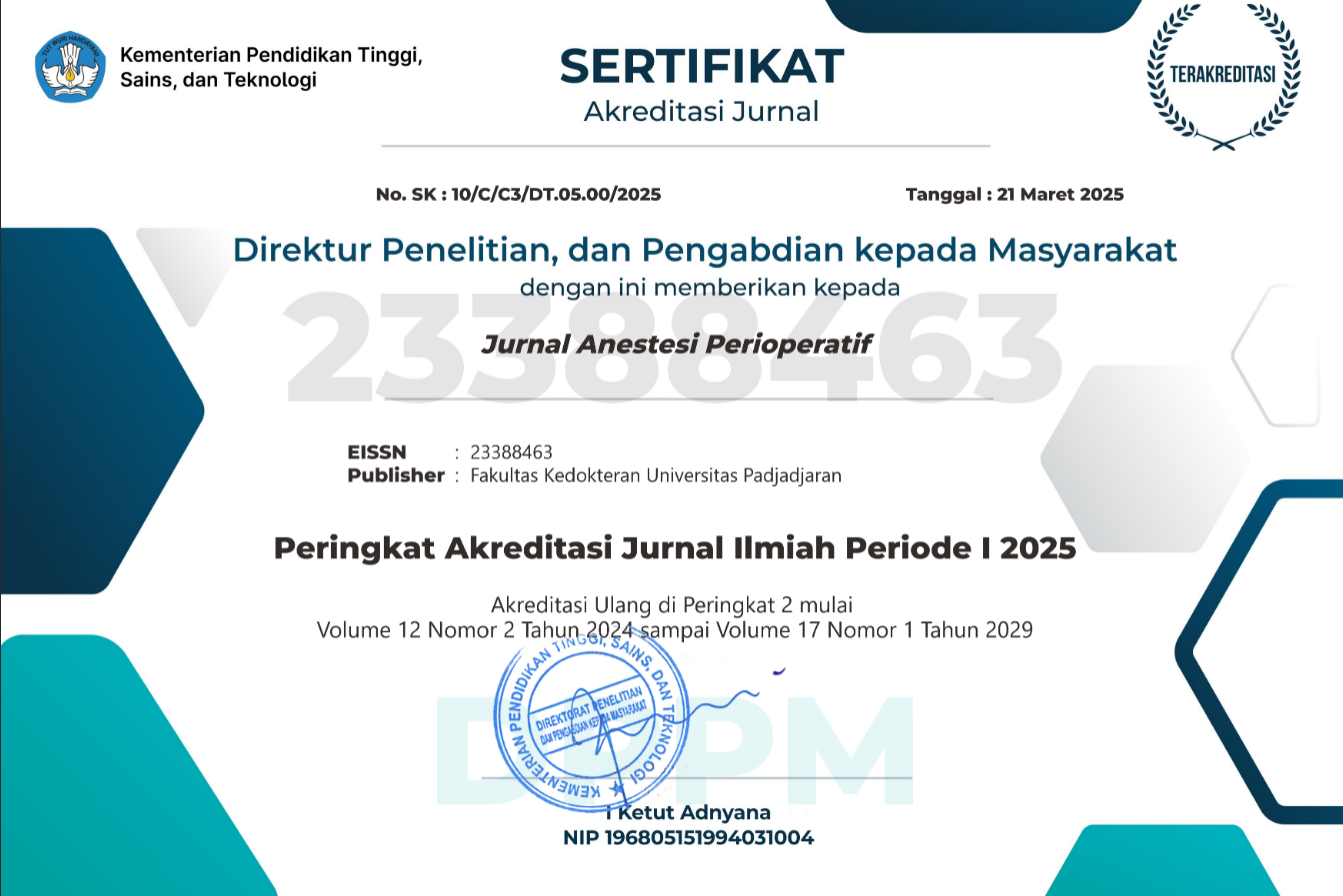Penutupan Defek Septum Ventrikel Secara Transtorakalis Minimal Invasif dengan Panduan Transesophageal Echocardiography (TEE)
Abstract
Defek septum ventrikel (ventricular septal defect/VSD) merupakan penyakit jantung bawaan yang paling sering ditemukan pada bayi dan anak. Penutupan defek ini masih memberikan tantangan tersendiri. Penanganan VSD dengan metode minimally invasive transthoracic merupakan perkembangan inovatif penutupan defek ventrikel. Laporan kasus ini bertujuan memperkenalkan metode terbaru dalam penanganan kasus VSD yang dilakukan di RSUP Dr. Mohammad Hoesin Palembang. Kami melaporkan serial kasus penutupan VSD menggunakan metode minimally invasive transthoracic dengan panduan transesophageal echocardiography (TEE). Transesophageal echocardiography digunakan selama prosedur sebagai panduan penempatan alat dan mengevaluasi hasil operasi. Empat pasien pada periode November 2015 menjalani prosedur penutupan defek, dua pasien laki-laki dan dua perempuan, usia 2 tahun sampai 4 tahun dengan berat badan 12–22 kg, dengan diameter VSD berdasar atas pemeriksaan ekokardiografi 4–7 mm. Penutupan VSD menggunakan metode minimally invasive transthoracic dengan panduan TEE melalui mini sternotomi menunjukkan prosedur yang aman dan efektif. Penggunaan TEE memberikan informasi yang sangat berguna selama periode intraoperatif.
Kata kunci: Defek septum ventrikel, minimal invasif, transesophageal echocardiography
Minimally Invasive Transthoracic Ventricular Septal Defect Closure Using Transesophageal Echocardiography Guidance
Ventricular septal defect (VSD) is the most common congenital heart disease found in infants and children. Up until now, management of VSD closure remains as a challenge for clinician. Ventricular septal defect closure with minimally invasive transthoracic method is an innovative development of ventricular defect closure. This case report aims to introduce the method of minimally invasive transthoracic VSD closure, which is the latest method in handling cases of VSD conducted at Dr. Mohammad Hoesin General Hospital Palembang. We report a case series VSD closure by the method of minimally invasive transthoracic with transesophageal echocardiography (TEE) guidance. Transesophageal echocardiography is used during the procedure as guidance for the placement of the device, and to evaluate the results of operations. Four patients of the period November 2015. Two girls patients and two boys, ages 2 years to 4 years old weighing 12–22 kg, with a diameter of VSD echocardiography examination between 4–7 mm. The closure of VSD using minimally invasive transthoracic under TEE guiding through mini-sternotomy indicate a safe and effective procedure. The use of TEE provides very useful information during the intraoperative period.
Key words: Minimally invasive, transesophageal echocardiography, venticular septal defect
Keywords
Full Text:
PDFReferences
Li F, Chen M, Qiu ZK, Lu J, Wu WH. A new minimally invasive technique to occlude ventricular septal defect using an occluder device. Ann Thorac Surg. 2008;85:1067–71.
Holoshitz N, Kenny D, Hijazi ZM. Hybrid interventional procedures in congenital heart disease. MDCVJ. 2014;2:93–8.
Lin K, Zhu D, Tao K, Gan C, Tang H, Feng Y, dkk. Hybrid perventricular device closure of doubly committed subarterial ventricular septal defects: mid-term results. Catheter Cardiovasc Interv. 2013;82:225–32.
Liang X, Qian T, Lei F, Ruan F, Sun J, Peng X, dkk. Intraoperative device closure or perimembranous ventricular septal defect with transthoracic minimal invasion. Sch J App Med Sci. 2016;4(10D):3846–9.
Bai W, An Q, Tang H. Application of transesophageal echocardiography in minimally invasive surgical closure of ventricular septal defects. Tex Hearts Inst J. 2012;39(2):211–4.
Sun Y, Zhu P, Zhou P, Guo Y, Zheng SY. Intra-operative device closure of perimembranous ventricular septal defect without cardiopulmonary bypass under guidance of trans-epicardial echocardiography: a single center experience. J Cardiothoracic Surg. 2016;11:87.
Quansheng X, Silin P, Zhongyun Z, Youbao R, Shengde L, Qian C, dkk. Minimally invasive perventricular device closure of an isolated perimembranous ventricular septal defect with a newly designed delivery system : preliminary experience. J Thorac Cardiovasc Surg. 2009;137:556–9.
Zang GC, Chen Q, Cao H, Chen LW, Yang LP, Chen DZ. Minimally invasive perventricular device closure of ventricular septal defect in infants under transthoracic echocardiographic guidance: feasibility and comparison with transesophageal echocardiography. Cardiovascular Ultrasound. 2013;11:1–8.
Parmana IMA. Perioperative transesophageal echocardiography (TEE), interpetasi dan panduan klinis. Jakarta: Aksara Bermakna; 2013.
Zhang GC, Chen Q, Chen LW, Cao H, Yang LP, Wu XJ, dkk. Transthoracic echocardiographic guidance of minimally invasive perventricular device closure of perimembranous ventricular septal defect without cardiopulmonary bypass: initial experience. Euro Heart J Cardiovasc Imaging. 2012;13:739–44
Yang XC, Liu DB. Minimally invasive perventricular device closure of ventricular septal defect: a comparative study in 80 patients. Chinese Med Sci J. 2014;29(2):98–102.
Sidebotham D, Merry AF, Legget ME, Edwards ML. Practical perioperative transesophageal echocardiography,with critical care echocardiography, Edisi ke-2. Philadelphia: Elsevier Saunders; 2011.
DOI: https://doi.org/10.15851/jap.v5n2.1113
Article Metrics
Abstract view : 5663 timesPDF - 10659 times
This Journal indexed by

JAP is licensed under a Creative Commons Attribution-NonCommercial 4.0 International License
View My Stats



